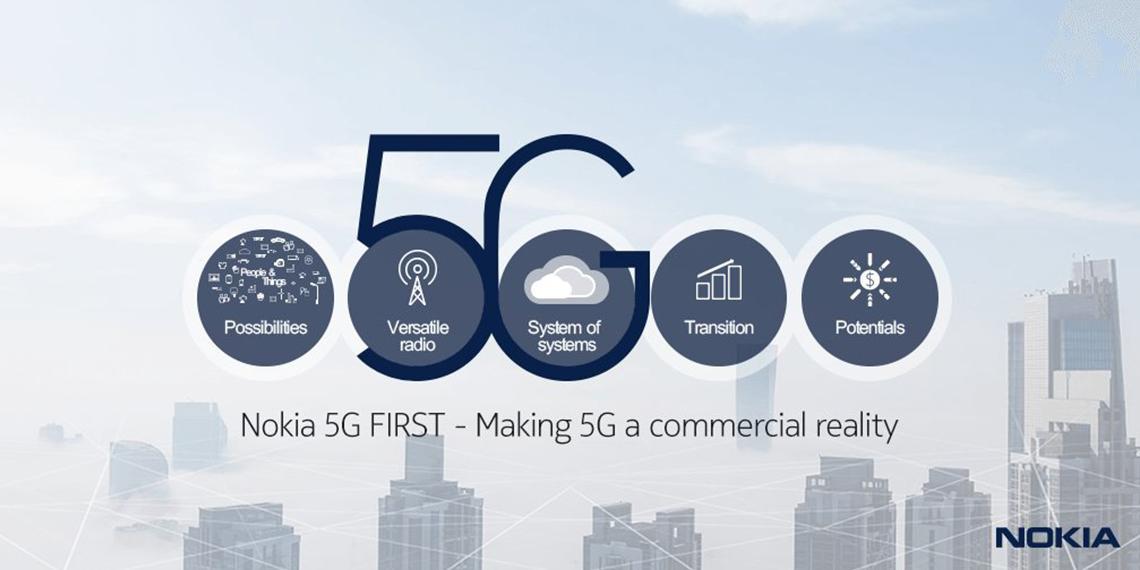Nokia has expanded its industry-leading mobile transport portfolio with new products and innovations specifically designed to address the critical requirements of the 5G era. This expansion aims to satisfy the increasingly complex and diverse challenges of today's evolving mobile infrastructure with the industry's most comprehensive range of 'anyhaul' mobile transport options. The programmable, end-to-end networking solutions build upon Nokia's deep pedigree in mobile, microwave, IP, optical, and fixed access technologies.
Ultra-broadband, IoT and the Cloud are driving a growing portfolio of services, use cases and business models. To satisfy the combined requirements for increased coverage, capacity and reduced latency, radio access and core networks are evolving, including redistributing mobile functions and using cloud-compute technologies. This significantly impacts the underlying transport layer whose role of aggregating and interconnecting traffic must also evolve and stay ahead of changes to the mobile layer. As a result, 5G era transport networks must massively scale, provide flawless connectivity with low latency, and employ programmability to provision services as quickly and dynamically as the cloud-based applications and mobile elements it connects.
Nokia has developed a broad portfolio of next generation 'anyhaul' transport solutions with new additions in microwave, IP, optical, and fixed access solutions, all being launched at MWC 2017. In addition, new innovations will be demonstrated including the ability to use 5G wireless spectrum as a transport mechanism for 5G services. All capabilities leverage Nokia's early investments in SDN and virtualization to deliver the programmable IP interconnectivity needed to assure the heightened service requirements, and with an evolutionary path to support past, present and future mobile technologies on a common infrastructure.
Nokia's entire portfolio has been enhanced for latency-sensitive Ethernet 'fronthaul'. These new capabilities in microwave, IP, packet optical and fixed access products complement Nokia's existing optical WDM-based CPRI fronthaul solution.
The Nokia portfolio has also been optimized for 10Gbps cell site connections, up from the previous 1Gbps interface which has dominated 2G/3G and LTE backhaul deployments for nearly a decade. With these capacities comes greater need for high availability and each product offers enhanced capabilities, including timing, synchronization and OAM, optimized to their specific technologies.
The 5G era will leverage cloud technologies, creating a more dynamic application environment that will strain the more static transport networks built in the past. To alleviate this, the enhanced Nokia transport solution is programmable, allowing mobile operators to rapidly address changing market requirements and deliver premium broadband and IoT services when and where needed, in the most efficient way.
To share insight on future innovations, Nokia will demonstrate at MWC 2017 a 5G wireless mmWave-based small cell deployment with self-backhauling capabilities. Using an innovative cloud-based mesh topology manager, it creates an in-band meshed network with self-organizing, self-healing and load-balancing capabilities.
Nokia is also announcing the following mobile transport product innovations:
· The Nokia Wavence Microwave Portfolio introduces a new family of ultra-broadband transceivers. The ultra-broadband transceiver twin, a 'dual carrier in a box' radio, and the ultra-broadband transceiver 80, a compact E-band radio, support carrier aggregation and carrier SDN to deliver multi-gigabit, low latency and programmable microwave transport. Nokia Wavence is the evolution and the new brand of the Nokia 9500 Microwave Packet Radio family.
· The Nokia 7250 Interconnect Router R6 (IXR-R6) is a new IP/MPLS router with terabit-scale, low latency, improved port densities and support for next-generation interfaces, such as Ethernet fronthaul, that expands and complements Nokia's IP/MPLS mobile transport solutions including the 7705 SAR, 7210 SAS and 7750 SR product families.
· The Nokia 1830 family introduces new functionality to further enhance its optical anyhaul mobile transport solutions. New Integrated Packet Transport cards for the Nokia 1830 Photonic Service Switch address Ethernet anyhaul applications by combining the scalability of 100G packet aggregation and coherent DWDM with ultra-low latency and industry leading time synchronization. Additionally, the Nokia 1830 Versatile WDM Module (VWM) adds optical protection switching, assuring high availability of WDM fronthaul traffic.
· The Nokia 7360 ISAM FX access nodeand7368 ISAM ONToptical network termination devices extend the performance of Passive Optical Networks (PON) and are designed to cost effectively introduce more bandwidth with 10Gbps for PON and Point-to-Point technologies. Including network synchronization support, the new capabilities enable operators to easily leverage existing fiber-to-the-home deployments for 'anyhaul' applications.









